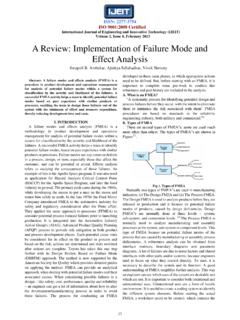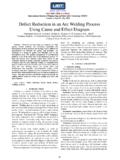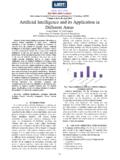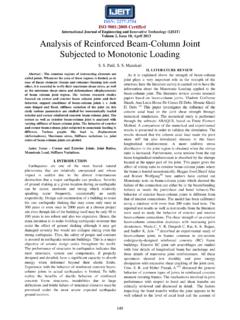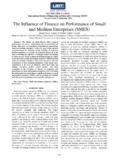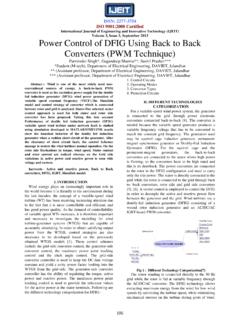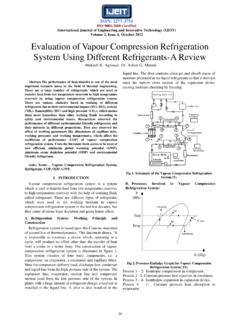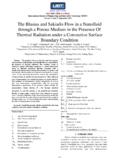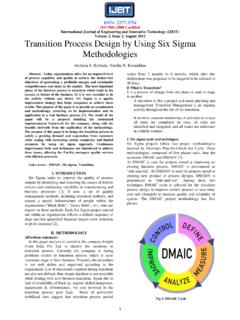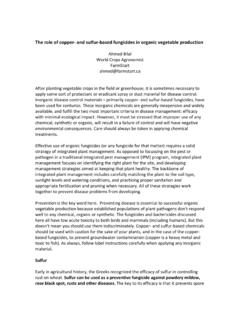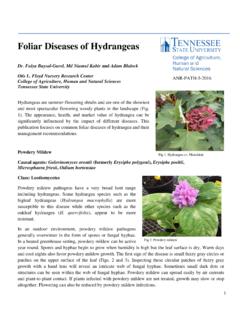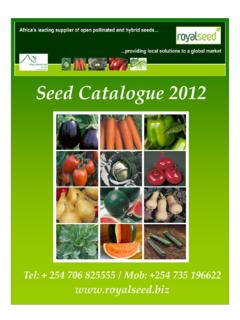Transcription of Protective Foliar Approaches against Downy and Powdery ...
1 ISSN: 2277-3754 ISO 9001:2008 Certified International Journal of Engineering and Innovative Technology (IJEIT) Volume 3, Issue 9, March 2014 324 Abstract Evaluating the efficacy of different plant resistance inducers and/or bio-agents treatments against Foliar diseases incidence revealed that plant spray with treatments, [Calcium chloride + S. cerevisiae + Chitosan] and [Potassium bicarbonate +Thyme oil] resulted in the highest reduction in Foliar diseases Downy and Powdery mildews diseases incidence and severity on cantaloupe plants comparing with fungicides treatment was carried out under commercial plastic houses conditions. The applied Foliar treatments could highly reduce the incidence of both Downy and Powdery mildews as well as suppress the development of both diseases expression comparing with fungicide treatment.
2 The obtained results in the present study has shown the potential of tested some plant resistance inducers as effective inhibitors against Downy and Powdery mildews when used alone or combined with antagonistic bioagent S. cerevisiae. Index: Calcium chloride, Cantaloupe, Chitosan, Downy mildew, Thyme oil, Fungicides, Plant Resistance Inducers, Potassium bicarbonate, Powdery mildew, S. cerevisiae. I. INTRODUCTION Cantaloupe (Cucumis melo L. var. reticulates Ser.) is one of the most popular cucurbit crops in Egypt either for local consumption or exportation. Downy and Powdery mildews are most destructive to cucumber and cantaloupe, though all cucurbits are susceptible. Although Powdery mildew has a long history in greenhouse production, Downy mildew has recently been the focus of attention and concern. Both diseases can contribute to significant economic losses in many greenhouse horticultural crops.
3 Although the two disease share the name "mildew', they are very different. Powdery mildew infections reduce crop aesthetics and value but usually do not result in plant death. In contrast, Downy mildew infections often result in plant death as well as the loss of aesthetics [1]. Downy mildew caused by the fungus like Pseudoperonospora cubensis is among the most serious diseases affecting cantaloupe production, with a high severity, especially at the time of fruit maturity [2,3]. Meanwhile, Powdery mildew caused by Sphaerotheca fuliginea is a very common disease that can reduce yield (fruit quantity and/or size) and market quality (flavor, color, storability, etc) in melons [4,5]. It is well known that Successful control of Downy and Powdery mildews using chemical control of plant diseases greatly cause environmental pollution and increase in the accumulated toxic substances in human food chain.
4 On the other hand, using other trials of disease management, biological control, plant extracts, antioxidants and agricultural practices, could give enough efficient results. The best way to ensure success of a disease- management program is to use integrated disease-control measures [6]. Generally, IPM is regarded as the use of environmentally safe practices to reduce the disease incidence and development or use of multiple control tactics integrated into a single pest control strategy [7]. For example, different natural products, , biocontrol agents, plant extracts and natural compounds were used as an IPM program to control Powdery mildew of greenhouse crops [6,8]. Since economic thresholds have not been established for most plant pathogens, an IPM takes a somewhat different approach in plant disease control.
5 Salts have been previously studied as Foliar applied control agents for Powdery mildews on various horticultural crops. A recent review [9] discussed the use of different Foliar applications including compost or plant extracts, surfactants, and inorganic salts. In Israel, research has demonstrated that the severity of Powdery mildew on cucumber, grape, nectarine, mango, and rose can be reduced through Foliar applications of phosphate and potassium salts [10,11]. Furthermore, Foliar application of calcium chloride has been also reported to delay ripping and control mould disease in strawberries [12]. Application of sodium bicarbonate or calcium chloride significantly reduced the early blight incidence and severity [13]. They added that Calcium chloride proved higher efficacy for reducing both disease incidence and severity than that of sodium bicarbonate when applied either alone or combined with Saccharomyces cerevisiae.
6 Calcium administered to the plant through the nutrient feed has been reported to be important for resistance to bacterial wilt resistance in tomato [14]. Moreover, it was found that KHCO3 applications were effective in reducing the severity of Powdery mildew on E. japonica and pumpkin [15,16]. Furthermore, Chiosan, in recent years, the importance of chito-saccharides as plant growth promoting and disease control agents has been emphasized [17,18]. Chitosan has been shown to induce defense responses in different plants [19,20]. Also, Chitosan oligomers was found to induce defense responses in grapevine leaves and a stimulation of chitinase and -1,3-glucanase activities [18]. On the other hand, essential oils are promising alternative compounds which have an inhibitory activity on the growth of pathogens. It is possible that essential oils could be used in plant disease control as the main or as adjuvant antimicrobial compounds [21].
7 It is well established that some plants contain compounds able to inhibit the microbial growth [22]. These plant compounds can be of different structures and different mode of action Protective Foliar Approaches against Downy and Powdery Mildews of Cantaloupe under Plastic Houses Conditions Nehal S. El-Mougy, M. M. Abdel-Kader, Lashin ISSN: 2277-3754 ISO 9001:2008 Certified International Journal of Engineering and Innovative Technology (IJEIT) Volume 3, Issue 9, March 2014 325 when compared with antimicrobials conventionally used to control the microbial growth and survival [23]. The present work was aimed to evaluate the inhibitory effect of some plant resistance inducers against Downy and Powdery diseases incidence and severity of cantaloupe grown under plastic house conditions. II. MATERIALS AND METHODS Evaluating the efficacy of different plant resistance inducers and/or bio-agents treatments against Foliar diseases was carried out under plastic house conditions located at Nubaria region, Behiera Governorate, Egypt.
8 The following treatments were applied as Foliar spray: 1. Calcium chloride (20mM) + S. cerevisiae 10x1010 cfu/mL (10ml/L) + Chitosan ( ) 2. Potassium bicarbonate (20mM) + Thyme oil ( 5ml/L) 3. Control (received only the fungicides Approaches following the Protective program recommended by Agriculture Research Centre, Protected Cultivation, Ministry of Agriculture and Reclaimed soil), Table (1). Table (1) Protective program against fungal diseases for growing cantaloupe in plastic houses and its financial cost * No. Time of Treatment Disease Fungicide Concentration (ml & gm /100 liter) Dose / plastic house (gm & ml) 4 After 7 days from previous spray Downy mildew Ridomil Gold 200 gm 200 gm 5 After 7 days from previous spray Powdery mildew Tobaz 100 40 ml 40 ml 6 After 7 days from previous spray Downy & Powdery mildews Amistar- Top 50 ml 50 ml 7 After 10 days from previous spray Downy mildew Previcure N 250 ml 250 ml 8 After 10 days from previous spray Downy mildew Aquagen-pro 40 gm 40 gm 9 After 7 days from previous spray Powdery mildew Tobaz-100 40 ml 40 gm 10 After 7 days from previous spray Powdery mildew Sulpher 300 gm 300 gm 11 After 7 days from previous spray Powdery mildew Copper Oxychloride 300 gm 300 gm 12 After 10 days from previous spray Downy mildew Previcure N 250 ml 250 ml 13 After 7 days from previous spray Downy & Powdery mildews Amistar- Top 50 ml 50 ml * The followed Protective program is recommended by Agriculture Research Centre, Protected Cultivation.
9 Ministry of Agriculture and Reclaimed soil The experimental plastic house consists of 5 rows, each ( x 60m, width x long) divided into 3 parts 20m long, and every part considered as one replicate. Five replicates were used for each particular treatment in complete randomized design. The growing vegetables were sprayed with proposed treatments 4 times with 15 days intervals after transplanting [24]. At all locations, the growing vegetables in the experimental plastic houses received only the recommended pesticides against harmful insects, aphids, trips, white fly, etc. as needed. Meanwhile, only the check control received traditional programs for controlling Foliar diseases which recommended by the follow up committee of Protected Cultivation Administration Office, Ministry of Agriculture and Soil Reclamation. Monitoring and scouting of Foliar diseases incidence, Powdery and Downy mildews of Cucumber, Pepper and cantaloupe & early and late blights of Tomato were recorded till the end of growing season.
10 Percentages of disease incidence and severity were recorded at 60, 90 and 120 days of transplanting date. At the end of growing season the accumulated yield was calculated for each particular treatment in both experimental and control (Fungicide treatment). Disease assessment: Disease incidence: Percentage of each Foliar disease incidence was recorded as the number of diseased plants relative to the number of growing plants for each treatment, then the average of disease incidence was calculated. Disease severity: Percentage of each Foliar disease severity was recorded as following equation: ( n x c ) = _____ X100 N Whereas: = Disease severity % n = Number of infected leaves per c = Category number N= Total examined leaves Disease severity scale from 0 to 4 according to [25] was followed, whereas: 0 = No leaf lesions; 1 = 25% or less; 2 = 26-50 %; 3 = 51-75 %; and 4 = 76-100% infected area of plant leaf.
